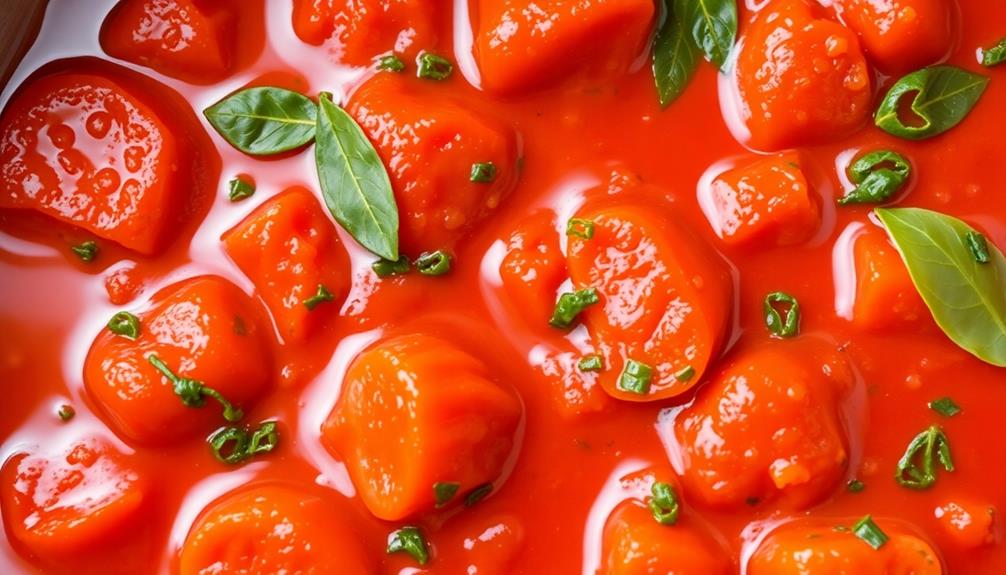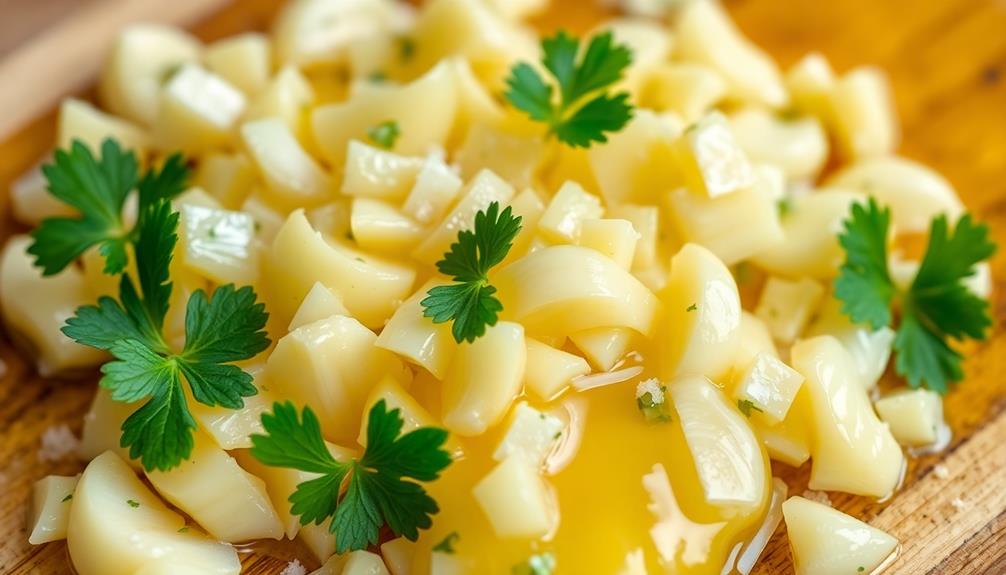Craft a delicious homemade tomato sauce that celebrates the tomato's journey from the Americas to its widespread adoption in Italian cuisine. Start by rinsing and chopping fresh tomatoes for optimal flavor. Sauté aromatic garlic and onions, then add diced bell peppers for sweetness. Incorporate canned crushed tomatoes and let the flavors meld as the sauce simmers for 30 minutes. This balanced, flavorful sauce enhances pasta, pizza, and more. Elevate your culinary skills and bring joy to meals with this versatile homemade tomato sauce recipe. And if you want to learn more about its history and cooking steps, keep reading.
Key Takeaways
- Provide a detailed recipe for making a delicious tomato sauce, including key ingredients like fresh tomatoes, onions, garlic, and olive oil.
- Outline the cooking steps, such as sautéing the aromatics, adding canned crushed tomatoes, and simmering the sauce for optimal flavor.
- Highlight the historical origins and cultural significance of tomato sauce, tracing its evolution from the 16th century to its popularity in Italian and American cuisines.
- Describe the flavor profile of the homemade tomato sauce, emphasizing the balanced sweetness, savory notes, and gentle acidity.
- Discuss the versatility of the tomato sauce, explaining how it can be served over pasta, used as a pizza base, or paired with bread for dipping.
History
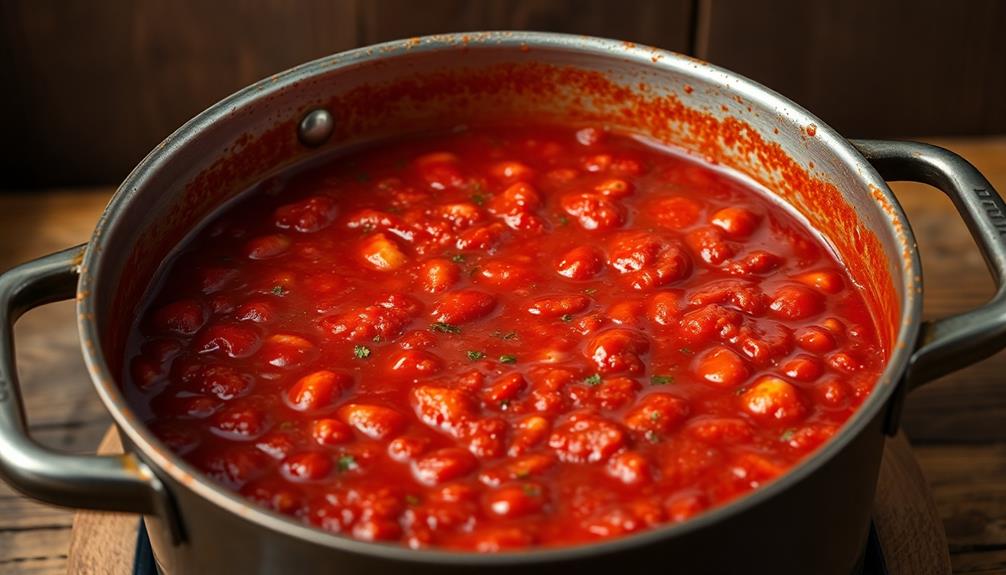
Tomato sauce has a rich history that dates back to the 16th century, when the plump, red fruit was first introduced to Europe from the Americas.
Initially, tomatoes were viewed with suspicion, as they were part of the nightshade family and believed to be poisonous. It wasn't until the 18th century that Italians in the Campania region began incorporating tomatoes into their cuisine, creating the first iterations of the beloved tomato sauce.
Over time, the recipe evolved, with the addition of herbs, garlic, and other spices.
As Italian immigrants brought their culinary traditions to the United States in the late 19th and early 20th centuries, tomato sauce became a staple in American kitchens.
Today, it remains a versatile and beloved condiment, used in a wide variety of dishes, from classic spaghetti to pizza and beyond.
Recipe
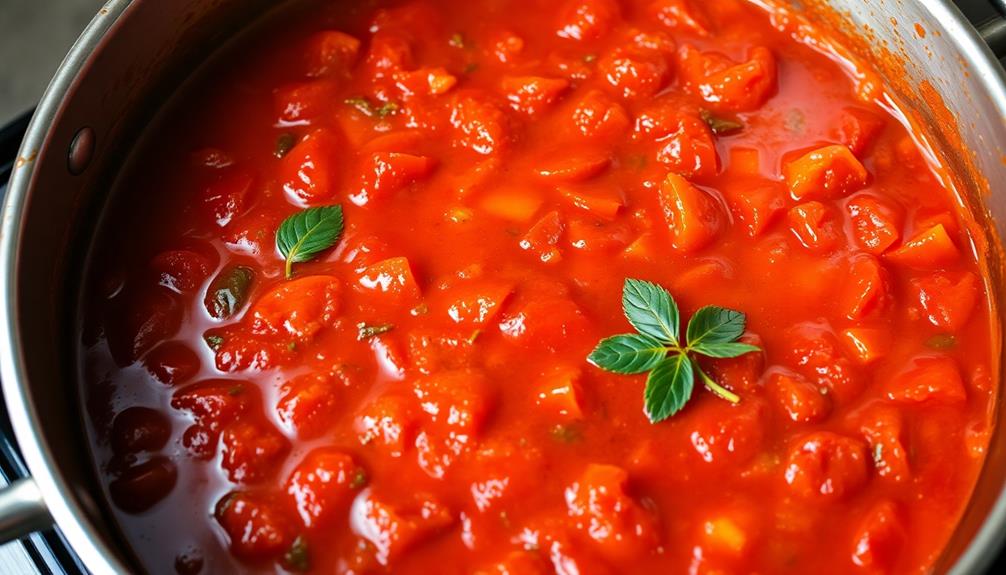
Tomato sauce is a versatile and essential ingredient in many Italian dishes. This classic recipe produces a rich, flavorful sauce that can be used in a variety of ways, from pasta to pizza to meatballs.
The key to a delicious tomato sauce lies in the quality of the ingredients and the slow, gentle cooking process that allows the flavors to meld together. This recipe features fresh, ripe tomatoes, fragrant herbs, and a hint of sweetness that balances the acidity of the tomatoes.
Ingredients:
- 2 pounds fresh tomatoes, diced
- 1 onion, finely chopped
- 3 cloves garlic, minced
- 2 tablespoons olive oil
- 1 teaspoon dried oregano
- 1 teaspoon dried basil
- 1/4 teaspoon red pepper flakes (optional)
- Salt and pepper to taste
- 1 tablespoon sugar (optional)
In a large saucepan, heat the olive oil over medium heat. Add the onion and sauté until translucent, about 5 minutes. Stir in the garlic and cook for an additional minute until fragrant.
Add the diced tomatoes, oregano, basil, red pepper flakes (if using), and a pinch of salt and pepper. Bring the mixture to a simmer and cook, stirring occasionally, for 30-45 minutes, or until the sauce has thickened to your desired consistency. Once the sauce has thickened, taste and adjust the seasoning with additional salt, pepper, or herbs as needed. While the sauce simmers, you can prepare a simple recipe for pesto sauce to serve alongside or mix into the dish for added flavor. For best results, combine the two sauces just before serving, or use the pesto as a fresh, vibrant garnish. As the sauce finishes simmering, prepare to layer the rich tomato base with the fragrant, herbaceous notes from your homemade pesto sauce recipe. The combination of the two sauces creates a harmonious blend of flavors that elevates the dish with every bite. Whether you swirl the homemade pesto sauce recipe directly into the tomato mixture or dollop it on top as a finishing touch, it brings a fresh burst of color and zest to the meal.
For a richer, sweeter sauce, add the tablespoon of sugar and continue simmering for an additional 10-15 minutes. Taste and adjust seasoning as needed.
Serve the tomato sauce over pasta, use it as a base for pizza, or enjoy it as a dip with crusty bread.
Cooking Steps
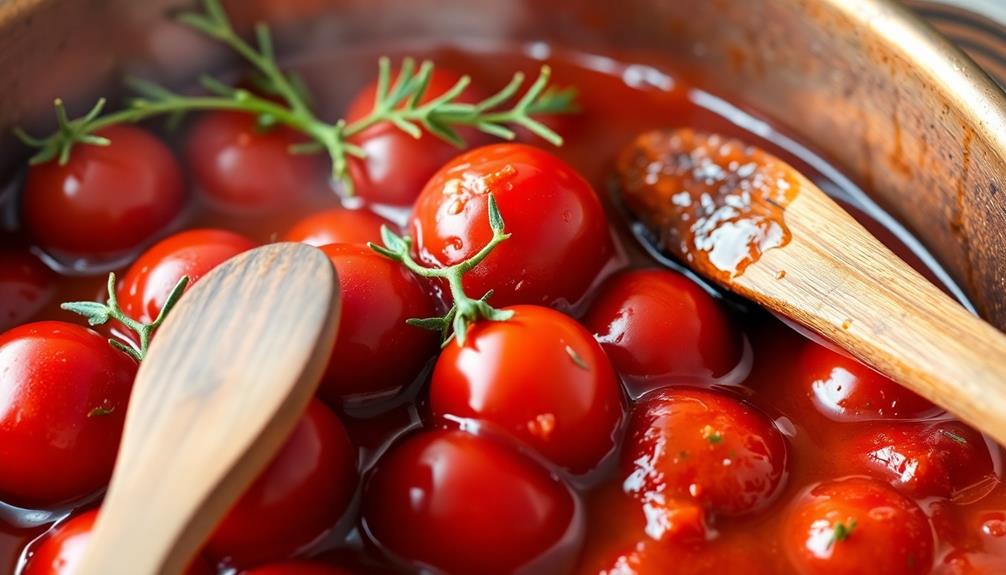
First, rinse and chop your tomatoes for the freshest flavor.
Next, sauté the garlic and onions in a pan to build an aromatic base.
Then, add the diced bell peppers to the mix, letting them soften.
Step 1. Rinse and Chop Tomatoes
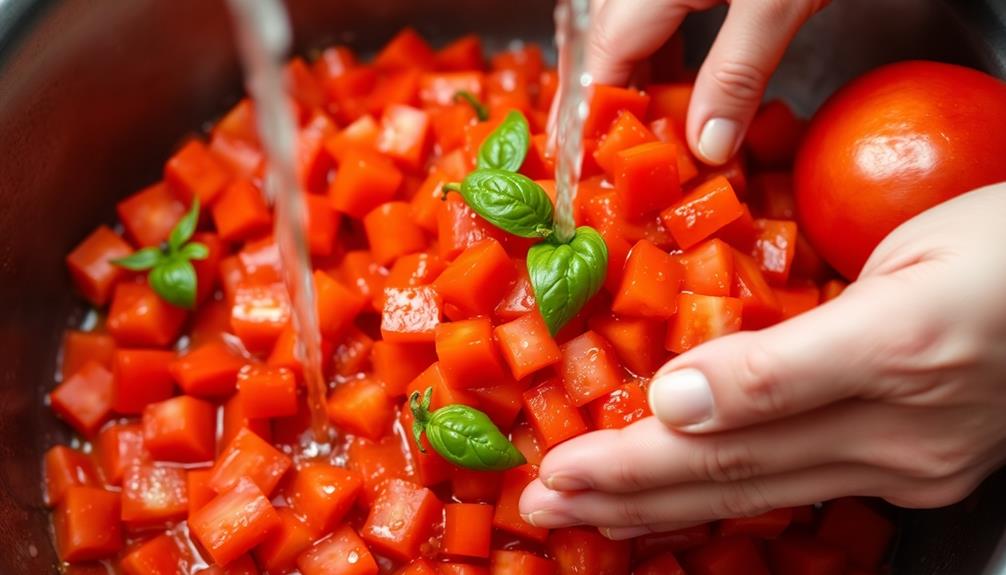
Rinse the plump, juicy tomatoes under cool, running water, gently rubbing their skins to remove any dirt or debris.
Once they're clean, place the tomatoes on a cutting board and grab a sharp knife. Carefully slice each tomato in half, then dice them into small, uniform pieces. This will help them cook down quickly and evenly in the sauce.
Be mindful of your knife skills – take your time and use caution to avoid any accidental cuts. The smaller you can chop the tomatoes, the better they'll incorporate into the sauce. Aim for pieces around 1/2 inch in size.
As you work, discard any tough stems or blemished areas. You want to use the highest quality, freshest tomatoes you can find for the best flavor.
Once all the tomatoes are chopped, you're ready to move on to the next step in creating your delicious homemade tomato sauce.
Step 2. Sauté Garlic and Onions
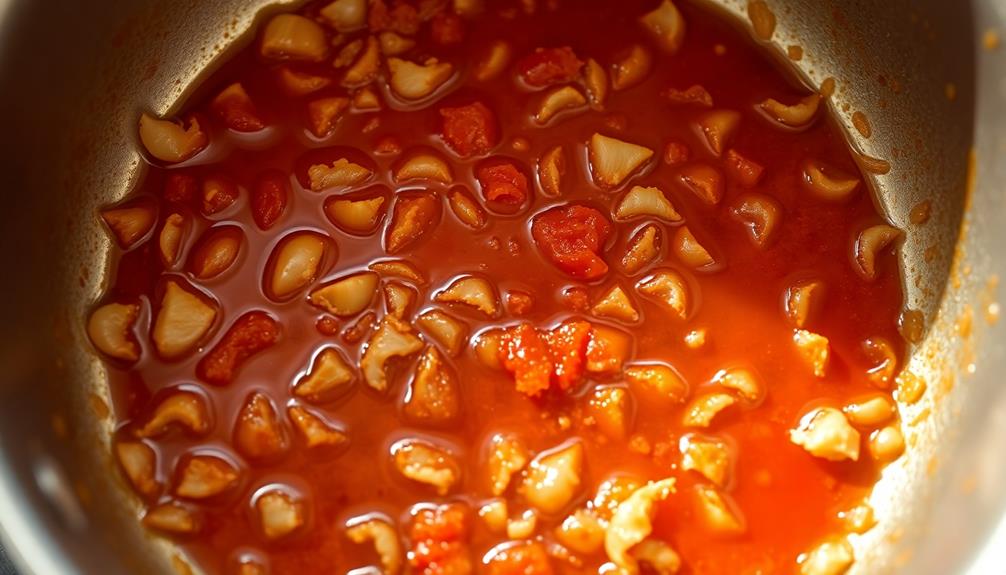
With the tomatoes chopped and ready, it's time to sautée the garlic and onions. This step is crucial for building the foundation of your delicious tomato sauce.
First, grab a large skillet and heat it over medium heat. Once the skillet is hot, add a few tablespoons of olive oil.
Next, mince the garlic and thinly slice the onions. Carefully add the garlic and onions to the hot oil, being mindful of any sizzling or popping.
Sautée the garlic and onions for 3-5 minutes, stirring frequently, until they become fragrant and the onions start to soften. Be careful not to let the garlic burn, as that can make it taste bitter.
Once the garlic and onions are sautéd to perfection, it's time to move on to the next step – adding the chopped tomatoes. This will help create the rich, flavorful base of your tomato sauce.
Step 3. Add Diced Bell Peppers
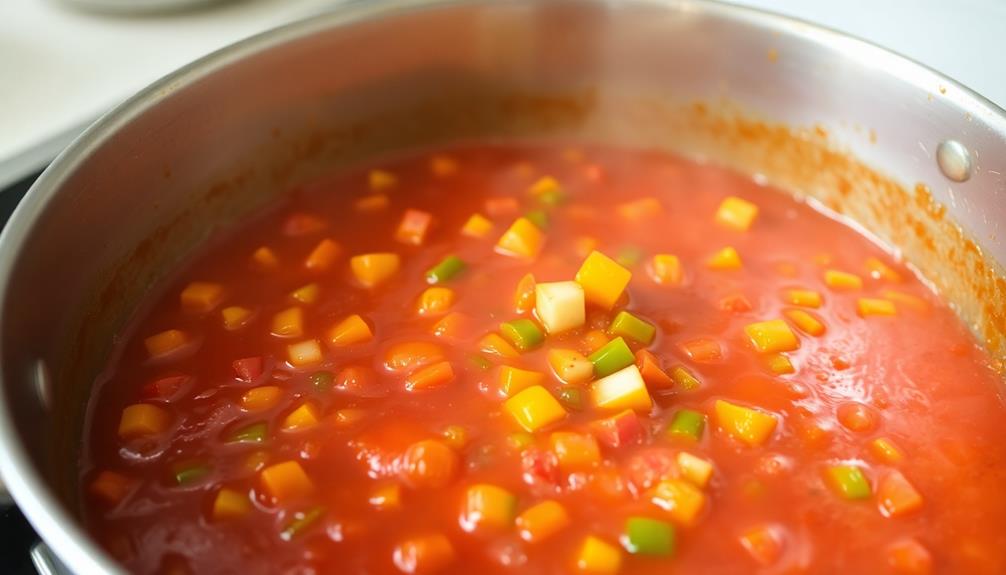
After sautéing the garlic and onions to perfection, it's time to add the diced bell peppers. Bell peppers not only provide a vibrant pop of color to the tomato sauce, but they also contribute a subtly sweet flavor and a satisfying crunch.
Incorporating seasonal produce like bell peppers can enhance the freshness of your dish, making it even more delightful for your palate. Consider how these peppers could complement a fermented vegetable plate, adding layers of flavor.
When preparing the bell peppers, be sure to dice them into bite-sized pieces, around 1/2-inch cubes. This ensures they'll cook evenly and integrate seamlessly into the sauce. You can use a variety of bell pepper colors – red, yellow, or orange – to create a visually appealing final dish.
Once the diced bell peppers are ready, add them to the sauté pan with the garlic and onions. Sauté the mixture for 5-7 minutes, stirring occasionally, until the peppers have softened and their flavors have blended with the other ingredients.
The bell peppers should retain a slight firmness, adding a pleasant texture to the sauce.
Step 4. Add Canned Crushed Tomatoes
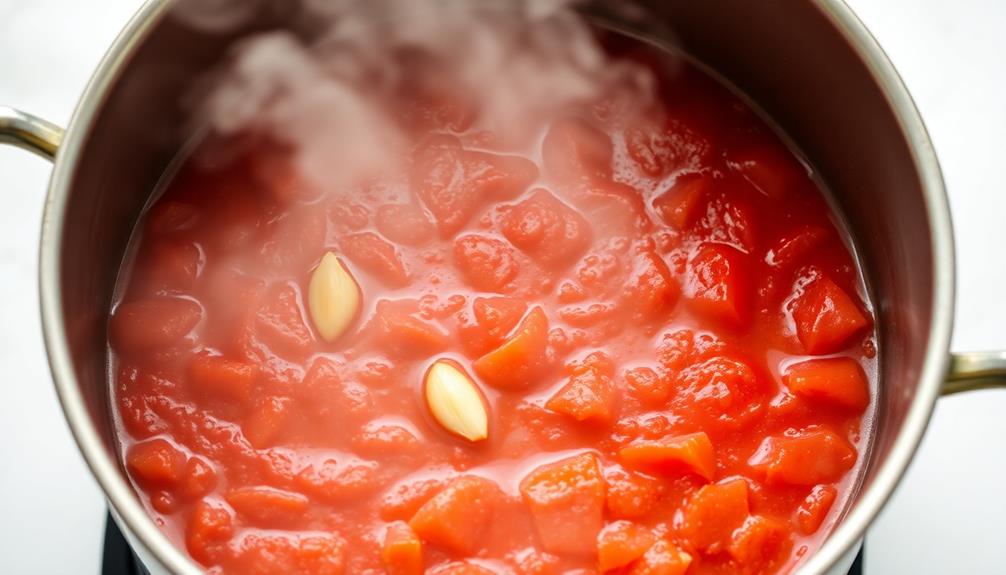
Next, you'll want to add a 28-ounce can of crushed tomatoes to the sautéed vegetables. Crushed tomatoes are a key ingredient in this homemade tomato sauce, providing a rich, concentrated tomato flavor.
When selecting canned crushed tomatoes, look for a brand that contains only tomatoes and their juices, without any added sugars or preservatives.
Carefully pour the can of crushed tomatoes into the saucepan, scraping out every last bit. The crushed tomatoes will complement the sautéed onions and peppers, creating a well-balanced sauce. Stir the mixture until the crushed tomatoes are evenly distributed and simmering.
Allow the sauce to simmer for about 10-15 minutes, stirring occasionally, to allow the flavors to meld together. This simmering process helps to thicken the sauce and intensify the tomato taste.
Be sure to taste the sauce and adjust the seasoning with salt and pepper as needed.
Step 5. Simmer Sauce for 30 Minutes
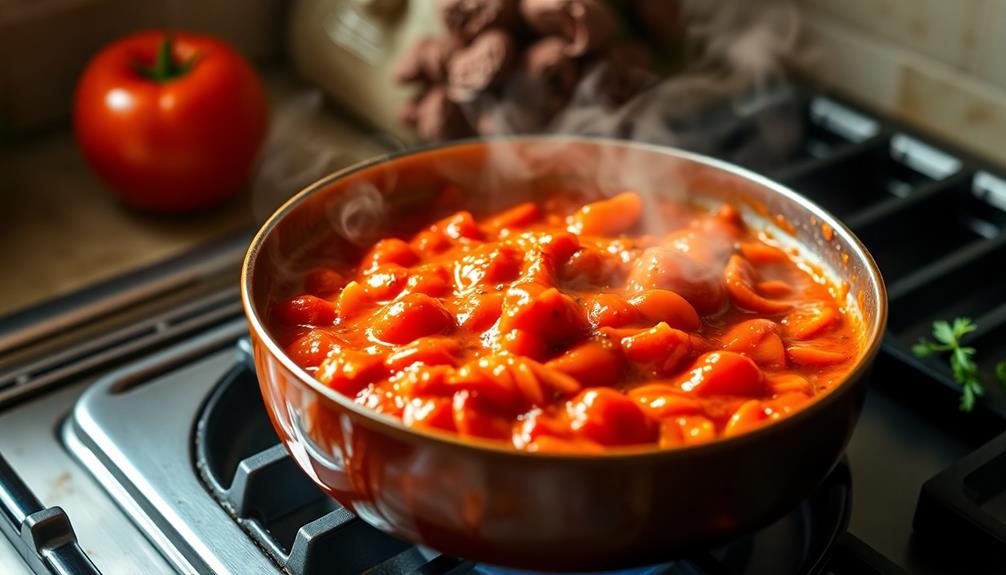
Simmer the sauce over medium-low heat for about 30 minutes, stirring occasionally. This step allows the flavors to meld and the sauce to thicken to your desired consistency. As the sauce simmers, it will reduce, concentrating the flavors and creating a rich, velvety texture. Be sure to stir the sauce periodically to prevent any burning or sticking to the bottom of the pan.
The simmering process serves several important purposes:
- It allows the acidity from the tomatoes to mellow, creating a more balanced and less tangy flavor profile.
- The longer simmering time breaks down the tomatoes further, resulting in a smoother, more cohesive sauce.
- Simmering helps the herbs and spices infuse their aromas and tastes throughout the sauce, enhancing the overall flavor.
- The reduction concentrates the sauce, making it thicker and richer in texture.
Adjust the heat as needed to maintain a gentle simmer, and keep a close eye on the sauce to ensure it doesn't overcook or dry out. After 30 minutes, your delicious tomato sauce will be ready to serve.
Final Thoughts
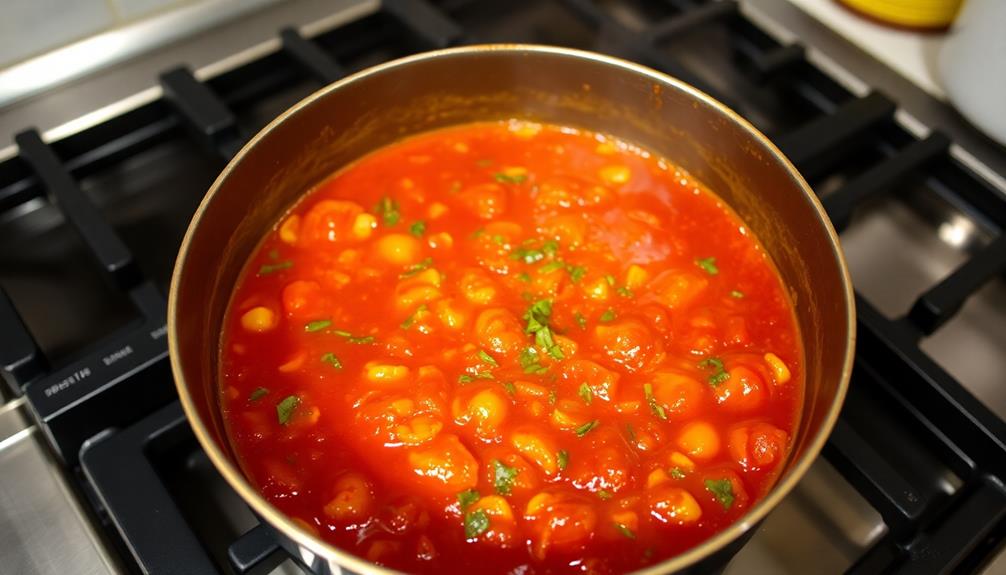
This homemade tomato sauce recipe is a true culinary delight. You've followed the steps diligently, simmering the sauce for the recommended 30 minutes, and now it's time to enjoy the fruits of your labor. The rich, vibrant color and enticing aroma of the finished product are a testament to your hard work.
As you take that first heavenly bite, you'll be struck by the perfect balance of flavors – the sweetness of the tomatoes, the savory depth of the herbs and spices, and the gentle acidity that ties it all together. This sauce isn't just a condiment; it's a celebration of the simple, honest ingredients that come together to create something truly extraordinary. The richness of each ingredient is allowed to shine, without being overshadowed or lost in the mix, making every bite a revelation. It’s in this simplicity that the power of tradition is upheld, reminding us that great food doesn’t need to be complicated. Just like learning **how to make caramel sauce**, where sugar, water, and heat transform into pure indulgence, this sauce creates a harmony that feels both nostalgic and new with every taste. With each spoonful, you’re reminded that food has the ability to tell stories, to evoke memories, and to create connections. Just as you might master how to make caramel sauce, discovering how simple elements like sugar and water can turn into golden, velvety magic, this sauce too demonstrates the beauty of trusting quality ingredients and time-honored processes. It’s a testament to the idea that sometimes, the basics are all you need to craft something unforgettable.
The versatility of this recipe is another highlight. Whether you choose to serve it over pasta, use it as a base for pizza, or simply enjoy it with crusty bread, the results will be consistently delicious.
With this homemade tomato sauce in your culinary arsenal, you're well on your way to becoming a master of Italian cuisine.
Frequently Asked Questions
How Can I Adjust the Spice Level of the Sauce?
To adjust the spice level, you can add more or less of the spicy ingredients. Start with a small amount of spice, then taste and add more if you want it hotter. You can also experiment with different types of spices.
Is It Possible to Make the Sauce in Advance?
Yes, you can absolutely make the sauce in advance. The sauce will keep well in the refrigerator for up to a week or in the freezer for several months. Just reheat it when you're ready to use it.
Can I Freeze Leftover Sauce for Later Use?
You can absolutely freeze leftover sauce for later use! Freezing is a great way to preserve the flavors and enjoy the sauce at a later time. Simply store it in an airtight container and it'll be ready when you need it.
How Can I Make the Sauce Thicker or Thinner?
To adjust the thickness of your sauce, simply simmer it longer for a thicker consistency or add more liquid like broth or water for a thinner texture. Experiment until you achieve your desired consistency.
What Are Some Alternative Ingredients I Can Use?
To alter the consistency, you can add more tomato paste for a thicker sauce or use less tomato paste and more crushed tomatoes for a thinner one. You can also try using different herbs, spices, or vegetables to change the flavor profile.
